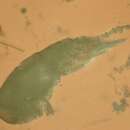Comprehensive Description
provided by Smithsonian Contributions to Zoology
Ratania atlantica Farran, 1926
Ratania atlantica Farran, 1926, p. 296, pl. 9: fig. 18; pl. 10: figs.11–12.—Vervoort, 1957, p. 146.
Ratania and the Myzopontiidae have no mandibular palp, and the terminal segment of the 1st antenna bears an esthete. However, Ratania differs from genera within Myzopontiidae in that Ratania 1st antenna has fewer segments, the 2nd antenna is uniramous, the oral cone is less produced, and the mandibular blade is more of a cutting-type, than a piercing-type.
Farran (1926) stated that R. atlantica closely resembles R. flava Giesbrecht, 1892, and gave only a brief description of the female.
MATERIAL STUDIED.—11 samples contained R. atlantica:
R. atlantica was found only in samples which also contained Pseudolubbockia dilatata. Four females deposited in the United States National Museum (121432–121434).
FEMALE.—Body (Figure 22) length 2.46 mm (mean of 10 specimens; range 2.21 to 2.63 mm). Prosome 4-segmented with cephalosome expanded laterally. Rostrum a ridge produced ventrally from tergum of cephalosome. Urosome 5-segmented; genital segment slightly longer than combined length of 2 postgenital segments. Caudal rami slightly more than twice as long as wide, almost twice the length of anal segment. Anal segment and caudal rami with row of spinules on ventral posterior borders. Dorsal surface of prosome and urosome bear scattered refractile points; minute spinules densely cover most body surfaces, giving appearance of coarse-grained texture.
First antenna (Figure 23) 7-segmented. Armature: segment I–7; II–2, 1 esthete, 1 spine; III–1, 1 spine; IV–2, 1 spine; V–2; VI–1, 1 spine; VII–11, 2 esthetes. Terminal segment with 2 setae arising from same base; 2 esthetes on this segment each about twice the length of the 1st antenna, the proximal esthete with a thickening of the anterior margin.
Second antenna similar to Giesbrecht’s (1892, pl. 48: fig. 40; 1899, pl. 10: fig. 21) illustrations for R. flava, except stronger terminal seta than in R. flava.
Labrum (Figure 24a) slightly produced from oral area; cone shaped, with distal row of short setules.
Mandible (Figure 24b) with long, narrow, stalklike neck; appendage terminates in a tip with 5 serrations and apical indentation setting off 3 more serrations, all of which are irregular.
First maxilla (Figure 24c) differs from that of R. flava in proportional lengths of 3 spinulose setae of coxa and in having clusters of setules on outer margin. Palp with 3 long spinulose setae and 1 small nude seta.
Second maxilla (Figure 24d) 2-segmented; basal segment with cluster of setules on inner surface. Second segment with 2 indistinct lines of fusion; 1 at midlength, accentuated by a small spine and a few setules, and 1 distally. Distal half of segment produced as slightly curving claw, with scattered setules.
Maxilliped as shown by Giesbrecht (1892, pl. 48: fig. 43; 1899, pl. 10: fig. 22) and Saraswathy (1961, fig. 7) for R. flava. Giesbrecht’s drawings differ; the 1899 figure shows line of segmentation on the hook. IPHC specimens show an indistinct line of fusion at that point.
Legs 1–4 with trimerous rami, resembling illustrations of Giesbrecht (1892, pl. 48: figs. 42 and 47) and Saraswathy (1961, figs. 10–13) for R. flava.
Leg 5 (Figure 24e) with flat free segment armed with finely barbed setae; the lengths of the 2 short medial setae and 3 longer lateral setae varied between specimens. A finely barbed seta arises from body near insertion of free segment.
Leg 6 (see Figure 22a) probably represented by ridge on anterior margin of opening of oviduct, bearing 2 small spines.
MALE.—Body (Figure 25) length 2.53 mm (mean of 5 specimens; range 2.43 to 2.62 mm). Prosome resembles that of female, more tapered anteriorly. Urosome 6-segmented; genital segment slightly wider than long. Refractile points scattered over prosome and urosome, as in female, and most body surfaces, appendages, and mouthparts densely covered with minute setules more conspicuous than on female. Rostral area similar to that of female.
First antenna (Figure 26) 9-segmented, nonclasping. Armature: segment I–4, 3 esthetes; II–3, 1 spine; III–l, 1 spine; IV–2, 1 spine; V–l; VI–1; VII–1, 1 spine; VIII–2, 1 esthete; IX–8, 1 esthete. Segments V–VI and VIII–IX correspond to segments V and VII in female. Dimorphism in male 1st antenna further expressed on segment I, where 3 esthetes replace 3 setae of female, and on segment II, where a long seta arises from site of esthete on female. In other respects, armature similar to corresponding areas of female, except for apparent lack of small seta on terminal segment.
Second antenna, labrum, mandible, 1st and 2nd maxillae, and maxilliped resemble those of female.
Legs 1–5 as in female.
Leg 6 ventrolateral on genital segment, armed with 1 seta.
DISTRIBUTION.—This record extends the distribution of R. atlantica to the Pacific Ocean. Previous records are of 1 female from the Bay of Biscay (Farran, 1926), 2 females from the Antarctic Ocean (Farran, 1929), 4 females, 1 male, and 1 juvenile from the Antarctic Ocean (Vervoort, 1957), and a few specimens from the Florida Current off Miami (Owre and Foyo, 1967).
- bibliographic citation
- Heron, Gayle A. and Damkaer, David M. 1969. "Five species of deep-water cyclopoid copepods from the plankton of the Gulf of Alaska." Smithsonian Contributions to Zoology. 1-24. https://doi.org/10.5479/si.00810282.20

